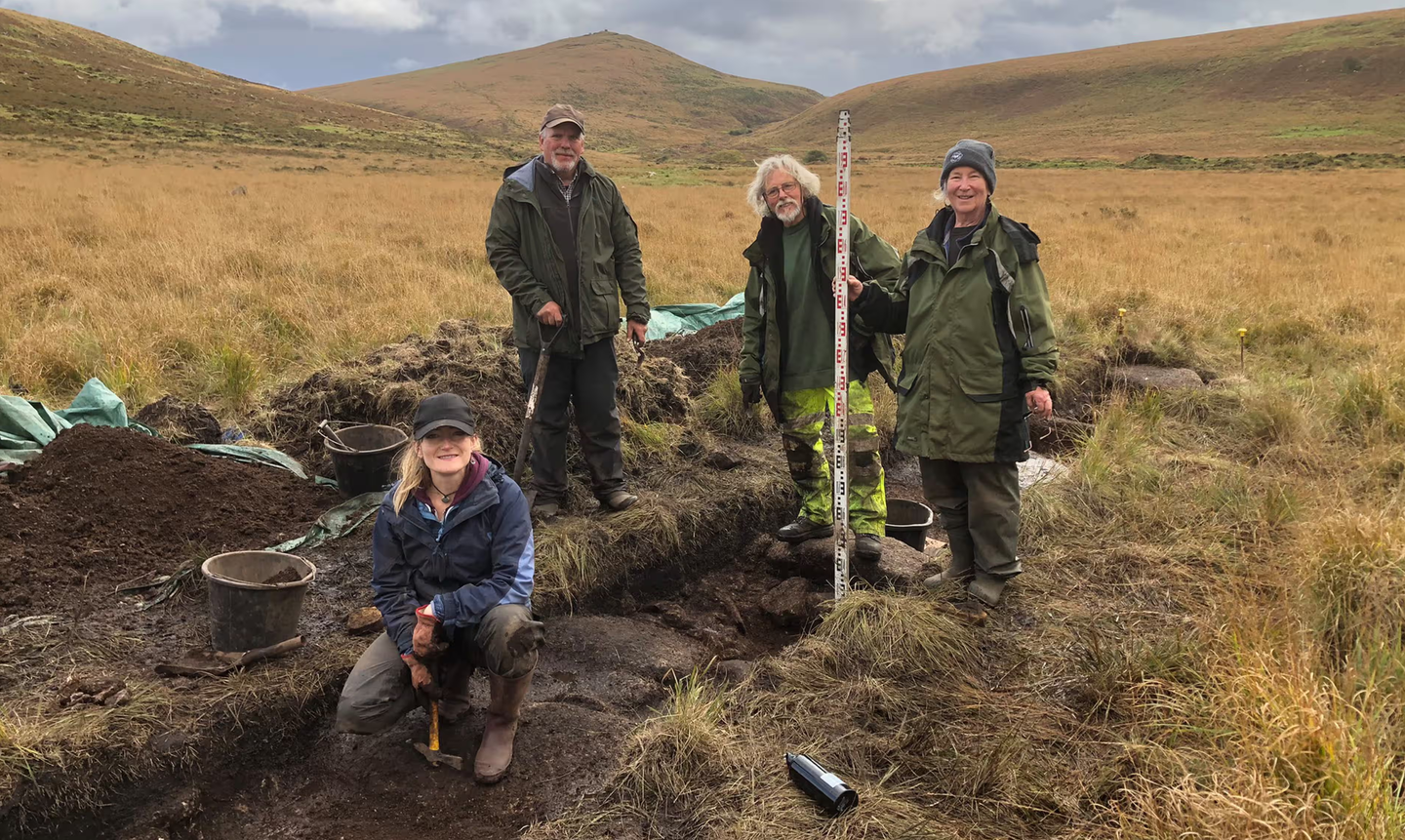5,000 year-old Stonehenge-like stone circles discovered in England
Two previously unknown Neolithic stone circles estimated to be about 5,000 years old were discovered in southwest England.

Alan Endacott (second from left) with dig volunteers at the newly discovered Metheral stone circle on Dartmoor. (CREDIT: Chris Walpole)
Two ancient stone circles have emerged from the grassy wilds of Dartmoor, offering a clearer picture of life 5,000 years ago. Found high in southwest England’s moors, these weathered stones hint at a larger ceremonial zone once sacred to Neolithic peoples.
Archaeologists have long suspected a “sacred arc” might stretch across the uplands. These new finds breathe life into that theory, reinforcing the idea that this windswept region once held deep spiritual meaning.
The discoveries come from Alan Endacott, a seasoned researcher with over 50 years of work in Dartmoor's prehistoric sites. In 2007, he found Sittaford—still the tallest known stone circle in southern England. His latest efforts build on that legacy.
After years of careful surveying and digging, Endacott recently uncovered two more circles. One lies near Irishman’s Wall, the other at a spot now called Metheral. Both are the result of his methodical fieldwork and patient excavation.
Stone Age Ingenuity
Metheral stands out as the larger site, with 20 stones—most toppled—forming a rough oval. The layout measures about 130 feet by 108 feet. Around its edge, traces of a low bank suggest it may have once been a henge, similar in form to Stonehenge or Orkney’s Ring of Brodgar.
To Endacott, the resemblance isn’t just coincidence. “People moved long distances during that period,” he said. “Those who built Metheral might also have visited Stonehenge or Orkney, trading and exchanging ideas.”
The find invites a broader look at how Neolithic people lived and what they believed. These circles are more than stones—they’re silent records of movement, trade, and shared beliefs across ancient Britain.
Related Stories
The positioning of Metheral at the northern tip of the proposed sacred arc further supports the notion that these circles were markers of a significant cultural or spiritual boundary. The arc, stretching five miles across the moor, aligns eight known stone circles in a near-perfect semicircle, seemingly enclosing some of the highest terrain in the region.
A Gate to the Sacred
A mile north of Metheral lies the second stone circle, located near a feature called Irishman’s Wall. Although only six stones remain visible, geophysical surveys confirmed the disturbed ground where additional stones once stood.
Endacott speculates that this site may have served as a gateway into the sacred arc from the north, welcoming travelers or pilgrims seeking access to what might have been regarded as hallowed ground.
Adding a poignant touch to the discovery, a collapsed dolmen near Irishman’s Wall has been named "the fallen brother dolmen." This title commemorates local residents who lost their lives in the world wars, linking the ancient with the modern in a shared respect for memory and loss.
Unanswered Questions and New Opportunities
Despite their significance, the purpose of these stone circles remains speculative. Were they ceremonial sites, territorial markers, or observatories aligned with celestial events? Each discovery raises more questions than it answers.
"These excavations exceeded my expectations and brought new evidence to light," Endacott said. "But they have also raised more questions about why they were built."
The sacred arc hypothesis itself is not new, but these findings reinforce its validity and suggest that it might be larger and more intricate than previously thought. Independent archaeologist Tom Greeves, an expert on Dartmoor, confirmed the significance of the finds, noting their contribution to understanding Neolithic activity in the region.
Meanwhile, University of Exeter archaeologist Susan Greaney sees the discoveries as a call to action for further research. "This arc of circles, measuring more than five miles across, is rather extraordinary," she remarked. "It suggests the upland area of northern Dartmoor was particularly special to prehistoric people."
A Neolithic Landscape Preserved
Dartmoor, named for the River Dart that originates there, is renowned for its rugged beauty and wealth of prehistoric sites. Beyond stone circles, the moor is dotted with burial mounds, chamber tombs, and enigmatic structures that hint at a complex Neolithic culture.
In those times, the landscape would have been vastly different, with more forest cover and perhaps fewer open expanses. The placement of the stone circles on high ground suggests a deliberate choice, one that may have been influenced by visibility, spiritual beliefs, or symbolic significance.
The interconnectedness of these sites with others, such as Stonehenge and the Ring of Brodgar, highlights a broader network of communication and shared cultural practices among Neolithic communities. This underscores the importance of ongoing research to uncover the full scope of their achievements.
Looking Forward
Endacott, now in his mid-60s, remains as committed as ever to his work. His team of volunteers, undeterred by Dartmoor’s harsh weather, continues to explore, and new leads promise additional discoveries.
"There are definitely other sites that I want to follow up on," he said. "We won’t be stopping any time soon."
The discoveries at Metheral and Irishman’s Wall are a reminder of the enduring mysteries of the past and the enduring spirit of those who seek to uncover them. They also serve as a testament to the ingenuity and interconnectedness of Neolithic society, whose echoes still resonate across the moors today.
Note: Materials provided above by The Brighter Side of News. Content may be edited for style and length.
Like these kind of feel good stories? Get The Brighter Side of News' newsletter.
Joseph Shavit
Head Science News Writer | Communicating Innovation & Discovery
Based in Los Angeles, Joseph Shavit is an accomplished science journalist, head science news writer and co-founder at The Brighter Side of News, where he translates cutting-edge discoveries into compelling stories for a broad audience. With a strong background spanning science, business, product management, media leadership, and entrepreneurship, Joseph brings a unique perspective to science communication. His expertise allows him to uncover the intersection of technological advancements and market potential, shedding light on how groundbreaking research evolves into transformative products and industries.



